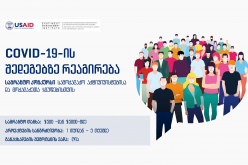State Preparedness to Natural and Man-made Disasters and Lessons Learned from the Tbilisi June 13 Tragedy
A year after the catastrophic flood of June 13th 2015, Tbilisi is still developing its disaster mitigation and response mechanisms. Currently efforts are underway to review existing legislation and its ability to properly codify prevention, preparedness, response, and recovery actions, as well as to improve coordination among various agencies and develop early-warning system.
On June 15, EWMI ACCESS organized a policy forum to discuss the issues mentioned above. Public officials from the Ministries of Environment and Natural Resources, Education and Science, Internal Affairs, as well as State Council on Crisis Management, and Emergency Management Agency, local CSOs and international organizations took part in the discussion.
The participants discussed details of the 13-14 June disaster and the responsive actions. As public officials claimed – considering the scarce resources and the magnitude of the disaster, the government did its best to respond and recover from the disaster. However, significant shortcomings hindered effective response (e.g. lack of rapid response coordination system, and other issues).
 The Crisis Management Center was established in February 2016 for effective coordination of various agencies during emergencies. The Center runs the fully equipped situation room and mobile center. The Center is also developing a previously nonexistent database of past natural disasters that will help authorities to analyse existing information and undertake preventive measures.
The Crisis Management Center was established in February 2016 for effective coordination of various agencies during emergencies. The Center runs the fully equipped situation room and mobile center. The Center is also developing a previously nonexistent database of past natural disasters that will help authorities to analyse existing information and undertake preventive measures.
The weather forecast agency is also better equipped – in 2016 the delta radar usage license was purchased and 8 units of weather forecast devices were installed in Tbilisi (some of them in the Vere Riverbed). The radar system and devices enable accurate weather forecast a couple of hours in advance.
New policy documents and legislative amendments are also being developed: the National Strategy on Disaster Risk Reduction is currently under preparation and will be finalized by the end of the year. Purpose of the document is to prevent natural disasters and reduce the damage. Furthermore the National Plan for Civil Defense was approved.
UNDP representative presented key findings of the assessment on performance of DRR during the disaster. Some of the key findings were:
- Lack of local multi-hazard risk assessment and historical disaster loss database
- Limited capacity for early warning (lack of data, capacities, community preparedness)
- Low levels of public awareness and preparedness for natural disasters
- The then City Master/Land use plan was not risk informed and the building codes were not based on a multi-hazard risk assessment. This has changed since 2016 – the new amendments to the construction code envision risks of the natural disasters while granting permissions for new constructions.
All participants spoke about importance of risk analysis and early warning system. Public education on disaster risks was also mentioned as a top priority. The Ministry of Education and Science is already working to develop relevant handbooks and teaching materials for school students – as they said, the Disaster Risk Reduction section will soon become part of the civic education curriculum.













